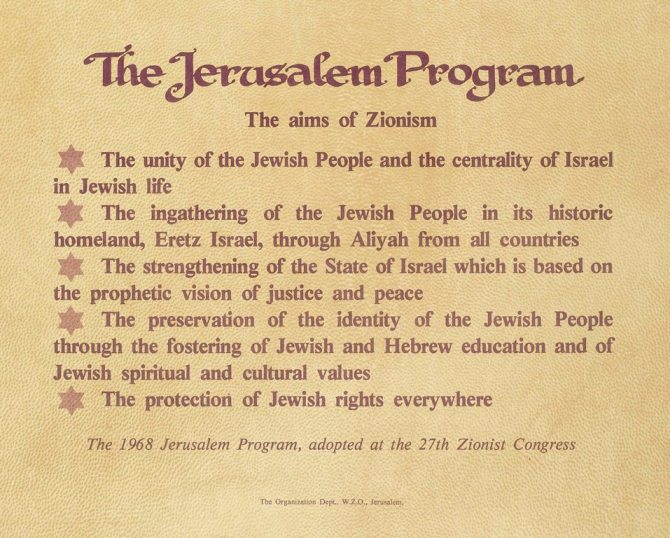The 37th Zionist Congress convenes this week in Jerusalem. The importance of the Zionist Congress is well-known: it is the supreme ideological and policy-making body of the World Zionist Organization. It convenes once every five years in Jerusalem and brings together delegates from around the world. On the occasion of the Congress we chose various posters and photographs from the CZA collections, which accompany the congresses from the beginning.
The beginning of Zionism
The first Zionist Congress convenes in Basle and accepts the Basle Program: Zionism strives to create for the Jewish people a home in Palestine secured by public law. Herzl, who wants the Congress to appear especially festive, insists that delegates come to the proceedings in formal evening attire. The Jewish and general press sends many reporters in order to cover this special Jewish assembly.
The building in Basle where the First Congress took place, 1897 | A painting of Herzl speaking at the First Congress
Participants of the First Congress, 1897 | Herzl with Israel Zangwill and Mrs. Pabri, the First Congress
The first congresses, led by Herzl, funded various Zionist institutions such as the Jewish Colonial Trust and the Jewish National Fund, in order to advance the aims of Zionism. There were discussions within the Zionist movement about the ways to achieve a Jewish state and where to establish it. The Uganda plan for example led to a big conflict at the 6th Congress.
Herzl gives the opening speech at the Second Congress, 1898 | Happy New Year card, Nahum Sokolow collection
Herzl among a group of Zionist journalists, 6th Congress, 1903 | Delegates from the Caucasus outside the 6th Congress
Establishing the Yishuv
After the First World War has ended, the 12th Congress convened in 1921. The Congress was marked by significant success of the Zionist movement: the Balfour Declaration. The Congresses convened in the 1920's turned to determine decisions related to the Yishuv and ways to advance its population. Keren Hayesod and the Jewish Agency were funded. The delegates discussed ways to encourage immigration to Palestine and decided to buy lands in the Jezreel Valley. It was also decided to open a University in Jerusalem.
Shekel campaign, the 13th Congress, 1923 | Menachem Ussishkin speaking at the 16th Congress, Zurich, 1929
Celebration of gymnastics: exercises of the ladies, 12th Congress, 1921 | Exhibition of Palestine products, 14th Congress, 1925
A struggle in Germany and Britain
With the rise of Hitler, the situation of the Jews in Europe deteriorated. Following the publication of the Partition Plan and the White paper, the relationship with Britain became worse. The 21st Congress convened in 1939, shortly before the outbreak of the war, discussed ways to overcome policy of the White paper.
Eighteenth Congress, Prague, 1933 | David Ben-Gurion at the 18th Congress | Shekel campaign, 21st Congress, Geneva, 1939. Design: Mechner & Wallish
On the way to statehood
During World War II there were no Congresses. After the war ended, the 22nd Congress convened in 1946. It had to discuss an urgent matter: closing the gates of Palestine to Jewish immigrants. Refugees who survived the Holocaust could not come to Palestine. The Congress discussed ways of struggle against the British and how to bring forward the establishment of a Jewish state.
Right: A poster about illegal immigration, 1946. Design: Mechner & Wallish | Left, up: Golda Meir at the 22nd Congress, Basle, 1946 | Left, down: David Ben-Gurion at the company of Jewish Agency emissaries in Germany, 22nd Congress, Basle, 1946
Jerusalem
The Zionist movement achieved its most important goal: the establishment of a Jewish state. Now, the movement had to re-define its goals. The 23rd Congress was held in Jerusalem on 1951. This Congress accepted "The Jerusalem Program", which formulated the main principals of Zionism.


The Jerusalem Program according to 27th Congress, 1968